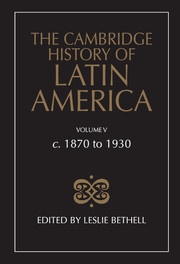Book contents
- Frontmatter
- PART ONE MEXICO
- PART TWO CENTRAL AMERICA AND THE CARIBBEAN
- PART THREE THE RIVER PLATE REPUBLICS
- PART FOUR THE ANDEAN REPUBLICSo
- 15 Chile from the War of the Pacific to the world depression, 1880–1930
- 16 Bolivia from the War of the Pacific to the Chaco War, 1880–1932
- 17 The origins of modern Peru, 1880–1930
- 18 Colombia, Ecuador and Venezuela, c. 1880–1930
- PART FIVE BRAZIL
- Bibliographical essays
- References
17 - The origins of modern Peru, 1880–1930
from PART FOUR - THE ANDEAN REPUBLICSo
Published online by Cambridge University Press: 28 March 2008
- Frontmatter
- PART ONE MEXICO
- PART TWO CENTRAL AMERICA AND THE CARIBBEAN
- PART THREE THE RIVER PLATE REPUBLICS
- PART FOUR THE ANDEAN REPUBLICSo
- 15 Chile from the War of the Pacific to the world depression, 1880–1930
- 16 Bolivia from the War of the Pacific to the Chaco War, 1880–1932
- 17 The origins of modern Peru, 1880–1930
- 18 Colombia, Ecuador and Venezuela, c. 1880–1930
- PART FIVE BRAZIL
- Bibliographical essays
- References
Summary
The year 1879 was nothing short of catastrophic for the Peruvian people. It marked the outbreak of the War of the Pacific which would bring untold travail, humiliation and ultimately national defeat. At the same time the widespread destruction engendered by the conflict cleared the path to economic modernization. During the next 50 years Peru, the quintessential ‘fẹudal’ Latin American society, would be pulled into the developing world economy, its modes of production reshaped by the special demands of Western industrial capitalism in the age of imperial expansion.
The half century after 1879 may be characterized as the dawn of modern Peru, a time not only of rapid economic modernization but also of social and political change. New elites emerged along the coast and coalesced to form a powerful oligarchy, whose political expression, the Civilist party, had before the close of the century seized control of the state. Under its paternalistic aegis and guided by the doctrines of liberal, laissez-faire positivism, currently in vogue throughout the continent, what Jorge Basadre, the dean of Peruvian historians, has called the ‘Aristocratic Republic’ (1895–1919) was born. The military was reorganized, professionalized and, at least temporarily, brought under civilian control for the first time since Independence. The machinery of government, although not entirely divorced from the traditional empleomania characteristic of the structures and forms of the colonial past, was overhauled, modernized and expanded to conform better with the demands and growing complexities of the modern export economy. It was, in short, a period marked by economic prosperity, political stability and relative social peace unmatched in the country's post-colonial history.
- Type
- Chapter
- Information
- The Cambridge History of Latin America , pp. 587 - 640Publisher: Cambridge University PressPrint publication year: 1986
References
- 38
- Cited by



